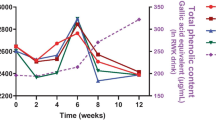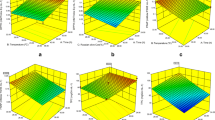Abstract
Processing of Russian olive water kefir (RWK), as a fermented functional drink made with Russian olive juice and water kefir grains with high antioxidant activity, into powder is crucial for improving its stability for the commercialization of this product. For the first time, this study aimed to encapsulate water kefir microorganisms and bioactive compounds in RWK using carrier materials to develop a synbiotic functional powder using spray drying as an encapsulation method. The goal was maximizing antioxidant activity, product yield, and survival rate of water kefir microorganisms in the produced Russian olive water kefir powder. The optimal spray drying conditions were observed to be at an inlet air temperature of 120ºC, 35 % feed flow rate, and 7 % concentration of drying aid. The effects of spray drying conditions on the quality of microcapsules were assessed and modeled, and the validity of the model was verified. Also, the spray-dried powder’s physicochemical properties were assessed and showed promising microbial and physicochemical characteristics compared with the freeze-dried powder.





Similar content being viewed by others
References
Gulitz A, Stadie J, Wenning M, Ehrmann MA, Vogel RF (2011) The microbial diversity of water kefir. Int J Food Microbiol 151:284–288. https://doi.org/10.1016/j.ijfoodmicro.2011.09.016
Pidoux M (1989) The microbial flora of sugary kefir grain (the gingerbeer plant): biosynthesis of the grain from Lactobacillus hilgardii producing a polysaccharide gel. World J Microb Biot 5:223–238. https://doi.org/10.1007/BF01741847
Atalar I, Dervisoglu M (2015) Optimization of spray drying process parameters for kefir powder using response surface methodology. LWT-Food Sci Technol 60:751–757. https://doi.org/10.1016/j.lwt.2014.10.023
Alsayadi M, Al Jawfi Y, Belarbi M, Sabri FZ (2013) Antioxidant potency of water kefir. J Microbiol Biotechnol Food Sci 2:2444–2447
Alsayadi M, Al Jawfi Y, Belarbi M, Soualem-Mami Z, Merzouk H, Sari DC, Sabri F, Ghalim M (2014) Evaluation of anti-hyperglycemic and anti-hyperlipidemic activities of water kefir as probiotic on streptozotocin-induced diabetic Wistar rats. J Diabetes Mellitus. https://doi.org/10.4236/jdm.2014.42015
Farzaei MH, Bahramsoltani R, Abbasabadi Z, Rahimi R (2015) A comprehensive review on phytochemical and pharmacological aspects of Elaeagnus angustifolia L. J Pharm Pharmacol 67:1467–1480. https://doi.org/10.1111/jphp.12442
Rodrigues KL, Caputo LRG, Carvalho JCT, Evangelista J, Schneedorf JM (2005) Antimicrobial and healing activity of kefir and kefiran extract. Int J Antimicrob Ag 25:404–408. https://doi.org/10.1016/j.ijantimicag.2004.09.020
Darvishzadeh P, Orsat V, Martinez JL (2021) Process optimization for development of a novel water kefir drink with high antioxidant activity and potential probiotic properties from Russian olive fruit (Elaeagnus angustifolia). Food Bioprocess Technol 14:248–260. https://doi.org/10.1007/s11947-020-02563-1
Huynh NT, Van Camp J, Smagghe G, Raes K (2014) Improved release and metabolism of flavonoids by steered fermentation processes: a review. Int J Mol Sci 15(11):19369–19388. https://doi.org/10.3390/ijms151119369
Barbosa J, Teixeira P (2017) Development of probiotic fruit juice powders by spray-drying: a review. Food Rev Int 33:335–358. https://doi.org/10.1080/87559129.2016.1175016
Magalhaes KT, Pereira GDM, Dias DR, Schwan RF (2010) Microbial communities and chemical changes during fermentation of sugary Brazilian kefir. World J Microb Biot 26:1241–1250. https://doi.org/10.1007/s11274-009-0294-x
Benzie IF, Strain JJ (1996) The ferric reducing ability of plasma (FRAP) as a measure of “antioxidant power”: the FRAP assay. Anal Biochem 239:70–76. https://doi.org/10.1006/abio.1996.0292
Brand-Williams W, Cuvelier M-E, Berset C (1995) Use of a free radical method to evaluate antioxidant activity. LWT-Food Sci Technol 28:25–30. https://doi.org/10.1016/S0023-6438(95)80008-5
Gulitz AJ (2013) Analysis of the diversity of water kefir microbiota by culture-dependent and-independent approaches. Dissertation, The Technical University of Munich.
Pereira ALF, Almeida FDL, Lima MA, Da Costa JMC, Rodrigues S (2014) Spray-drying of probiotic cashew apple juice. Food Bioprocess Tech 7:2492–2499. https://doi.org/10.1007/s11947-013-1236-z
Singh CS, Paswan VK, Rai DC (2019) Process optimization of spray dried Jamun (Syzygium cumini L.) pulp powder. LWT-Food Sci Technol 109:1–6. https://doi.org/10.1016/j.lwt.2019.04.011
AOAC (2005) Official methods of analysis. AOAC Int, Washington DC
Fazaeli M, Emam-Djomeh Z, Ashtari AK, Omid M (2012) Effect of spray drying conditions and feed composition on the physical properties of black mulberry juice powder. Food Bioprod Process 90:667–675. https://doi.org/10.1016/j.fbp.2012.04.006
Teijeiro M, Pérez PF, De Antoni GL, Golowczyc MA (2018) Suitability of kefir powder production using spray drying. Food Res Int 112:169–174. https://doi.org/10.1016/j.foodres.2018.06.023
Golowczyc MA, Silva J, Abraham AG, De Antoni GL, Teixeira P (2010) Preservation of probiotic strains isolated from kefir by spray drying. Lett Appl Microbiol 50:7–12. https://doi.org/10.1111/j.1472-765X.2009.02759.x
Igual M, Ramires S, Mosquera L, Martínez-Navarrete N (2014) Optimization of spray drying conditions for lulo (Solanum quitoense L.) pulp. Powder Technol 256:233–238. https://doi.org/10.1016/j.powtec.2014.02.003
Acknowledgements
The authors would like to thank the Canadian Natural Sciences and Engineering Research Council (NSERC) for their funding of this project.
Author information
Authors and Affiliations
Corresponding author
Ethics declarations
Conflict of Interest
None
Additional information
Publisher’s Note
Springer Nature remains neutral with regard to jurisdictional claims in published maps and institutional affiliations.
Supplementary Information
ESM 1
(PDF 282 KB)
Rights and permissions
About this article
Cite this article
Darvishzadeh, P., Orsat, V. & Faucher, S.P. Encapsulation of Russian Olive Water Kefir as an Innovative Functional Drink with High Antioxidant Activity. Plant Foods Hum Nutr 76, 161–169 (2021). https://doi.org/10.1007/s11130-021-00886-8
Received:
Accepted:
Published:
Issue Date:
DOI: https://doi.org/10.1007/s11130-021-00886-8




